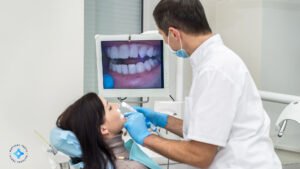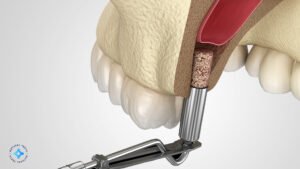For many patients, dental implants represent the gold standard in tooth replacement—offering durability, functionality, and a natural appearance. However, not everyone has sufficient jawbone density to support them. That’s where bone grafting comes in.
This advanced surgical procedure restores lost bone structure, creating a solid foundation for implants. Whether you’ve experienced bone loss due to gum disease, trauma, or tooth extraction, bone grafting can make the difference between an unstable restoration and a lifelike, long-lasting smile.
In this comprehensive guide, we’ll explore what bone grafting is, who needs it, the different types available, and how it enhances implant success. By the end, you’ll understand why this procedure is a game-changer for patients with low bone density—and how it can help you regain a confident, fully functional smile.
What Is Bone Grafting?
Bone grafting is a surgical procedure that rebuilds or reinforces weakened areas of the jawbone. Over time, tooth loss, periodontal disease, or injury can cause bone deterioration, making it difficult to support dental implants. A bone graft introduces new bone material—either from your own body, a donor, or synthetic sources—to stimulate natural bone regeneration.
This process is essential because implants need a strong foundation to integrate properly with the jaw. Without adequate bone, implants may fail or lead to complications. Bone grafting ensures stability, improves implant success rates, and helps maintain facial structure by preventing further bone loss.
Who Needs Bone Grafting?
Not every implant candidate requires bone grafting, but it’s crucial for patients with:
-
Significant jawbone loss due to prolonged tooth absence
-
Advanced gum disease (periodontitis) that has weakened bone structure
-
Trauma or injury affecting the jaw
-
Low bone density in the upper jaw (sinus lift may be needed)
-
Atrophic ridges (shrunken jawbone from long-term denture use)
If your dentist recommends bone grafting before implants, it’s because this step ensures the best possible outcome—giving you a secure, functional, and aesthetically pleasing result.
Types of Bone Grafts Explained
There are several bone grafting materials, each with unique advantages:
-
Autograft (Patient’s Own Bone) – Harvested from the jaw, hip, or tibia, this offers the highest compatibility and promotes faster healing.
-
Allograft (Donor Bone) – Processed from human donors, it eliminates the need for a second surgical site.
-
Xenograft (Animal-Derived Bone) – Typically bovine or porcine, treated for safety and biocompatibility.
-
Synthetic Grafts – Made from biocompatible materials like hydroxyapatite or calcium phosphate, mimicking natural bone.
Your dentist will recommend the best option based on bone volume needed, healing time, and your overall health.
The Bone Grafting Procedure: What to Expect
If you’re considering bone grafting for implants, here’s a step-by-step breakdown of the process:
-
Consultation & 3D Imaging – Advanced scans assess bone density and determine graft requirements.
-
Graft Placement – The selected material is positioned in the deficient area, often secured with membranes.
-
Healing & Osseointegration – Over 3-6 months, the graft fuses with your natural bone.
-
Implant Placement – Once healed, implants are surgically placed into the reinforced bone.
Most patients experience minimal discomfort, with manageable swelling and soreness. Sedation options ensure a comfortable experience.
Benefits of Bone Grafting for Dental Implants
Why is bone grafting worth it? Here are the key advantages:
✔ Stronger Implant Support – Prevents implant failure by ensuring solid bone integration.
✔ Preserves Facial Structure – Prevents sunken cheeks and premature aging caused by bone loss.
✔ Expands Treatment Options – Makes implants possible even for patients with severe bone loss.
✔ Long-Term Durability – Grafted bone integrates permanently, offering lasting stability.
Without grafting, implants in weak bone may loosen or fail prematurely. Investing in this step maximizes your implant success rate.
Recovery & Aftercare Tips
Proper healing is critical for graft success. Follow these guidelines:
-
Avoid chewing on the graft site to prevent displacement.
-
Take prescribed antibiotics to prevent infection.
-
Maintain oral hygiene with gentle rinsing (no vigorous brushing initially).
-
Attend follow-up visits to monitor bone integration.
Most patients resume normal activities within a few days, though full healing takes months.
Frequently Asked Questions About Bone Grafting
-
Is bone grafting painful?
Discomfort is minimal, managed with local anesthesia and sedation.
-
How long does bone grafting take to heal?
Initial healing: 2 weeks. Full integration: 3-6 months.
-
Can I get implants immediately after grafting?
No, waiting for bone integration is essential for stability.
-
What happens if I don’t get a bone graft?
Implants may fail or cause complications due to weak bone support.
-
Are there risks with bone grafting?
Rare, but possible infection or graft rejection (minimized with proper care).
-
How much does bone grafting cost?
Varies by graft type and complexity (500−3,000$).
-
Can smokers get bone grafts?
Smoking slows healing; quitting before surgery improves outcomes.
-
Is donor bone safe?
Yes, rigorously screened and sterilized for biocompatibility.
-
Will insurance cover bone grafting?
Some plans partially cover it if medically necessary.
-
Can bone grafting fix receding gums?
It restores bone, while gum grafts address soft tissue loss.
Conclusion:
A Strong Foundation for a Lifetime of Smiles
Bone grafting is more than just a preparatory step—it’s a vital investment in the long-term success of your dental implants. By restoring lost bone structure, this procedure ensures optimal stability, functionality, and aesthetics, allowing you to eat, speak, and smile with confidence.
If you’ve been told you don’t have enough bone for implants, don’t lose hope. Modern bone grafting techniques make it possible for almost anyone to enjoy the benefits of implant dentistry.






